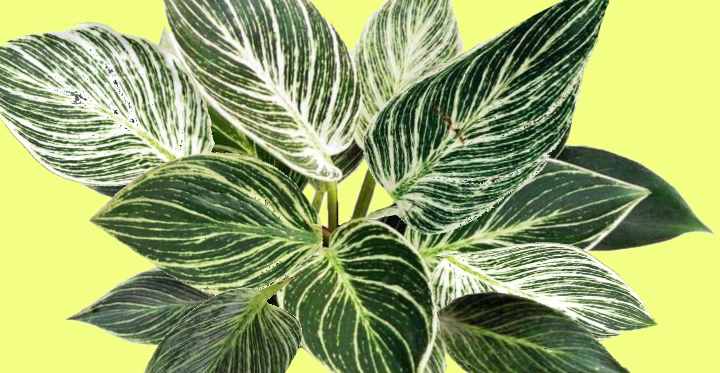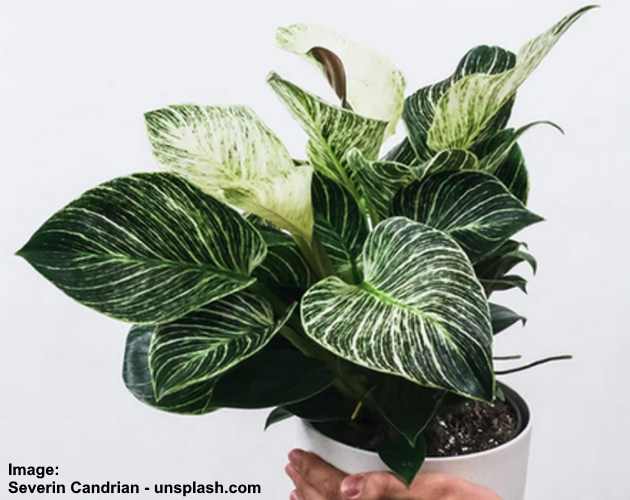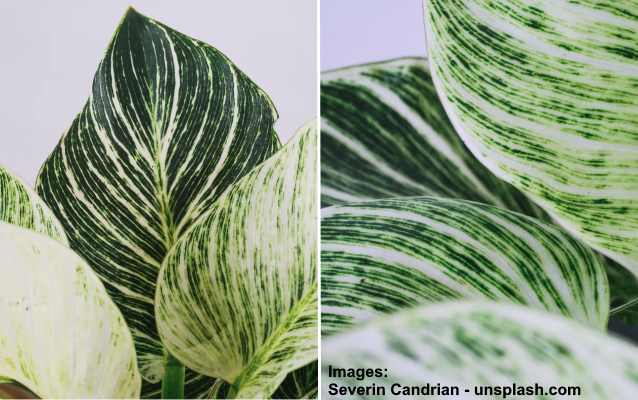Philodendron Birkin: Plant Care and Growing Guide (with Birkin Plant Pictures)

Philodendron Birkin is a stunning tropical houseplant, thanks to its rare variegation. A mature Philodendron Birkin has leathery, dark green glossy leaves with creamy-white pinstripes. The tropical philodendron plant starts with lime-green leaves and light yellowish thin stripes. As the Birkin plant matures, white variegation develops, giving the unique Philodendron leaves rare patterns on its pointed oval leaves.
Philodendron Birkin is one of the stunning flowering arum plants in the genus Philodendron. Apart from the Birkin plant, rare types of variegated philodendron plants include the Philodendron Pink Princess, Philodendron Brazil, and the Philodendron White Knight—one of the rarest philodendrons.
Philodendron Birkin plants are generally easy to care for at home. Although the compact, leafy plant is native to humid tropical regions, it adapts well to indoor conditions. With its pinstripe white variegation contrasting with glossy green leaves, the Philodendron Birkin is a colorful addition to your collection of tropical and rare houseplants.
This article is a complete guide to caring for the Philodendron Birkin variegated plant. At the end of the article, you’ll learn how to resolve common issues when growing Philodendron Birkin as a houseplant.
How to Care for Philodendron Birkin
To care for Philodendron Birkin, grow the compact houseplant in indirect sun, fertile well-draining potting mix, and relatively high humidity. Water the Birkin plant when the top 1” (2.5 cm) of soil is dry. Grow indoors in temperatures between 60°F and 75°F (18°C – 24°C). Fertilize every four weeks in the growing season.
What is Philodendron Birkin Plant?

Philodendron Birkin
Philodendron Birkin is a non-vining evergreen perennial plant native to Brazilian rainforests. There are around 489 species of philodendron, each with its own unique growth habits. Birkin is known for its striped creamy-yellow and dark green leaves that are oval to heart-shaped.
Compared to other philodendron plants, Birkin has unique variegation. Although the Birkin plant isn’t as rare and expensive as it once was, it’s still a sought-after unusual houseplant.
Philodendron Birkin Plant Growth Rate
Philodendron Birkin is a relatively fast-growing tropical houseplant with upward growth. A mature Birkin plant will take a few years to reach its maximum height of around 3 ft. (1 m). The Philodendron Birkin’s growth rate also depends on the size of the pot and growing conditions.
For example, to encourage faster growth, it’s a good idea to grow the potted Birkin in bright, indirect light and only water when necessary. This helps the leaves to grow well, keep variegation vibrant, and help the philodendron Birkin mature faster.
Philodendron Birkin Leaves

Philodendron Birkin leaf variegation
Philodendron Birkin has heart-shaped leaves with delicate yellowish-white to white pinstripes. The pointed oval leaves have a leathery feel and a glossy, dark green shine. You’ll notice that Birkin plant leaves are never the same. The rare variegation changes from leaf to leaf and can even change color.
The broad, thick, shiny Philodendron Birkin leaves usually emerge lime-green with slight variegation. As the Birkin matures, bright yellowish-white stripes arching from the center to the edges appear. Some mature Birkin plants may also have eye-catching bright yellow margins.
Some of the rarest Philodendron Birkin variegated plants have green leaves with pink or light red splashes along with the characteristic yellow striped markings.
Philodendron Birkin Rare Leaf Variegation
Philodendron Birkin has a rare type of leaf variegation. The unique variegation occurred when cultivating the Philodendron Rojo Congo. The grower noticed an unusual spontaneous mutation in one of the philodendron leaves. This type of rare variegation—called chimeric mutation—remained in propagated Birkin plants.
Although Birkin plant variegation is relatively stable, the variegation can revert. Philodendron Birkin reverting to the Rojo Congo plant causes the leaves to turn green again.
For more information on variegation in rare tropical houseplants such as Birkin, please read about the Monstera Deliciosa Albo Variegata.
What to Do if Philodendron Birkin Loses Variegation (Philodendron Birkin Plant Reverting its Variegation)
Unfortunately, Philodendron Birkin can occasionally start to lose its rare variegation and revert to being completely green. However, you can prevent a Birkin plant from reverting to its non-variegated form by taking a few steps.
Here is what to do if a Birkin plant is reverting its variegation:
- Ensure the variegated pinstripe plant is getting enough sunlight
- Cut back the Birkin plant to the last variegated leaf
- This means trimming off the leaves that are entirely green or have large green, non-variegated patches
If you care well for Philodendron Birkin, it’s rare that the plant reverts back and completely loses its yellow, white, and green variegation.
Philodendron Birkin Care Guide
Let’s look in more detail at how to grow a Philodendron Birkin plant indoors successfully. You’ll find that getting growth conditions right helps prevent a mature Birkin plant from reverting and losing its rare variegation.
Light Requirements to Grow Philodendron Birkin Plant
Philodendron Birkin plants thrive in indirect, bright light. Ensure that your variegated philodendron is protected from the intense rays of direct sunlight. A philodendron’s natural habitat is dappled sunshine under the tropical canopy. Place the potted Birkin on an east- or west-facing windowsill or behind a sheer curtain at a south-facing window.
Getting the right light requirements is crucial to Philodendron Birkin’s care. Too much direct sunlight causes the leaves to fade, wilt, and drop. Growing in shade results in the leaves losing their stunning variegation and reverting back to entirely green.
Ideally, a Philodendron Birkin grows best in eight to 12 hours of light a day. If you need to increase light—for example on dark winter days—then artificial light is ideal.
It’s good to remember that Birkin isn’t a plant that performs well in the shade.
The Best Soil to Grow Philodendron Birkin Houseplants
Potting soil for Philodendron Birkin should be loose, aerated, and drain well, yet retain enough moisture. The ideal philodendron soil is two parts sphagnum peat moss and one part perlite. Alternatively, you can buy a commercial potting mix for aroid plants or tropical houseplants.
The best soil for philodendron has peat moss because of its airy texture and moisture-retention properties. This allows the roots to stay hydrated and maintain healthy growth. Perlite is an excellent soil amendment for enabling excess water to drain quickly.
The potting soil around the Birkin plant roots should be consistently moist without being soggy. The top layer of soil should dry between watering.
How to Water Philodendron Birkin for Best Growth
Water a Philodendron Birkin as often as the top 1” to 2” (2.5 – 5 cm) of soil dries. To water a Birkin plant, pour filtered, room-temperature water until it flows from the pot’s drainage holes. Then wait until the potting mix has dried before watering again.
The best method for watering tropical houseplants is to drench the soil and let it dry. This keeps the soil partially moist without being too soggy. Of course, your philodendron’s pot must have drainage holes to allow water to flow out.
To know if it’s time to water a Philodendron Birkin, poke your finger into potting soil. If it’s dry, then you should water the plant. If there is still some moisture, wait for a few days before checking again.
Here are some handy tips when watering a Philodendron Birkin plant:
- Check the soil for dryness before watering
- Birkin plants need less hydration in cold weather than in hot, humid weather
- Moisture from philodendron soil in terracotta pots evaporates faster than in plastic ones
- Birkin plants go dormant in winter and need less watering
Philodendron Birkin Plant Temperature Requirements
Philodendron is an evergreen tropical plant that thrives in average home temperatures. The ideal temperature range for Birkin plants is temperatures between 60°F and 75°F (18°C – 24°C). To ensure healthy growth, keep the tropical philodendron out of cold drafts and away from direct heat.
You may notice that a Philodendron Birkin’s leaves start to curl in cold temperatures. This can happen if the plant is near a drafty window or in the air-conditioning airflow.
A reason for Birkin plant leaves to turn brown is if the pot is near hot radiators, heating vents, or furnaces. Brown patches usually appear first at the tips, and these can feel dry and crispy.
To care well for a Philodendron Birkin, try to keep it in even room temperatures and avoid sudden temperature fluctuations.
You can also grow Philodendron Birkin outside in USDA zones 10 and 11.
In temperate regions, a potted Birkin plant will grow outdoors in the summer in dappled sunlight. When the temperature drops below 60°F (16°C), you should take the plant back indoors. The minimum temperature for Philodendron Birkin is 50°F (10°C).
Humidity Requirements for Philodendron Birkin Plant
Philodendron Birkin grows best in humidity between 40 and 70 percent. The good news is that Birkin plants are versatile and adapt well to lower humidity levels. But suppose the air in your home is particularly dry. In that case, you may need to increase humidity to prevent brown leaf tips from appearing.
The easiest way to increase humidity is to set the philodendron pot on a humidity tray. Or you could try growing your tropical plants in a group to boost air moisture around your plants.
Philodendron Birkin Plant Fertilizer Needs
Philodendron Birkin plant foliage benefits from fertilization every two to four weeks. Use a water-soluble, balanced houseplant fertilizer diluted to half strength. The ideal philodendron fertilizer should have an NPK rating of 20-20-20.
If you don’t want to use chemical fertilizers, you can also apply an organic houseplant fertilizer. Or you can add worm casting to the potting mix every time you repot the Birkin.
How to Prune Philodendron Birkin Plants
Birkin Philodendron plants require minimal pruning. All you need to do is remove any dead or discolored leaves to keep the plant looking vibrant and healthy.
Pruning is sometimes necessary if a mature Philodendron Birkin reverts to its non-variegated state. If you notice that leaves start to turn green, you should remove all leaves that lose their variegation. New variegated foliage should begin to grow back.
How to Propagate Rare Philodendron Birkin Plants
Stem cuttings are the best way to propagate Birkin plants. All you need to do is choose a stem with a node and a couple of aerial roots. Cut below the node and place the stem cutting in water to root.
After six to eight weeks, when roots have appeared, transfer the cutting to a pot with appropriate potting soil.
How to Repot Variegated Philodendron Birkin
A fast-growing Philodendron Birkin usually requires repotting every year. You can tell it’s time to repot the plant if roots are growing out of the pot’s drainage holes. Also, slow-draining soil and water pooling on the soil’s surface are signs a Birkin plant requires repotting.
To repot a variegated Birkin, choose a pot one to two sizes larger than its current one. After removing the plant from its current pot, check the roots for signs of damage. Prune dead roots as necessary.
Is Philodendron Birkin Plant Toxic
Like all plants in the genus Philodendron, the Birkin plant is poisonous to cats and dogs. The National Capital Poison Center says that philodendron plant leaves contain calcium oxalate crystals. These toxins can cause swelling, inflammation, and pain on contact with the skin or oral cavities.
Doctors warn that humans or animals ingesting parts of philodendron plants can experience drooling, painful swallowing, or loss of speech. Coming into contact with the plant’s sap can lead to rashes, swelling, and skin inflammation.
Pests that Affect Philodendron Birkin Plant Growth
Philodendron Birkin plants are relatively resistant to pests. However, common houseplant pests such as thrips, mealybugs, and spider mites can affect plant growth. The best way to get rid of plant bugs naturally is to use a neem oil solution.
Mix 2 tsp. neem oil and 1 tsp. dish soap with 1 quart (1 l) of water in a spray bottle. Mix well and spray all sides of infected Birkin leaves once a week to get rid of pests fast.
To protect your plants from pest damage, it’s vital to recognize the signs of houseplant pests. Detecting and eradicating these bugs at an early stage will protect your plants from more extensive damage. It is also a good idea to quarantine any plants you suspect of having pests.
Diseases Affecting Philodendron Birkin Plant Growth
Most fungal diseases affecting Philodendron Birkin growth are caused by overwatering. Dark spots on leaves, weak growth and wilting are all signs of root rot or fungal infections. To avoid diseases from killing a rare Philodendron Birkin, always water the plant when the soil is partially dry.
If you notice signs of plant disease, prune off all affected leaves. To help revive a dying Philodendron Birkin, it may be necessary to replace the potting soil, trim all mushy brown roots, and repot in a fresh potting mix. To help your Philodendron thrive, ensure the plant grows in optimal conditions.
Philodendron Birkin Plant Care — FAQs
Philodendron Birkin is a stunning houseplant that adds a burst of bright color to any room. Sometimes, the variegation can start to fade if the Birkin plant reverts to its original form. However, there are a few other issues that can affect a Philodendron Birkin’s growth.
Why is my Birkin yellow?
Noticing yellow Philodendron Birkin leaves usually indicates that you’re overwatering the plant. Soggy soil prevents the plant’s roots from absorbing enough nutrients. This results in weak growth, low energy, and the green leaf parts can’t photosynthesize properly.
Why are my Birkin leaves curling?
Philodendron Birkin leaves that begin to curl are usually the result of underwatering. However, excessively cold or dry environments can also make philodendron leaves curl. If you notice that Birkin plant leaves have curled up, check the soil for dryness and increase heat and humidity.
Why is my Philodendron Birkin dying?
Overwatering is the most common reason Philodendron Birkin leaves wilt and start to die. Too much soil moisture causes roots to rot and decay, starving the plant of vital nutrients. Additionally, fungal infections can affect the Birkin, causing it to die.
To bring a Philodendron Birkin back to life, hold off watering until the soil dries. Additionally, it may be a good idea to repot the plant in fresh potting soil. This allows you to inspect root damage and trim off any mushy, decaying roots.
Related articles:
- Amazing Types of Philodendron with Pictures and Care Guide
- Philodendron Pink Princess (Philodendron Erubescens): Care Guide
- Philodendron Hederaceum Brasil: Care Guide
- Philodendron Xanadu Plant: How to Grow Philodendron Winterbourn
